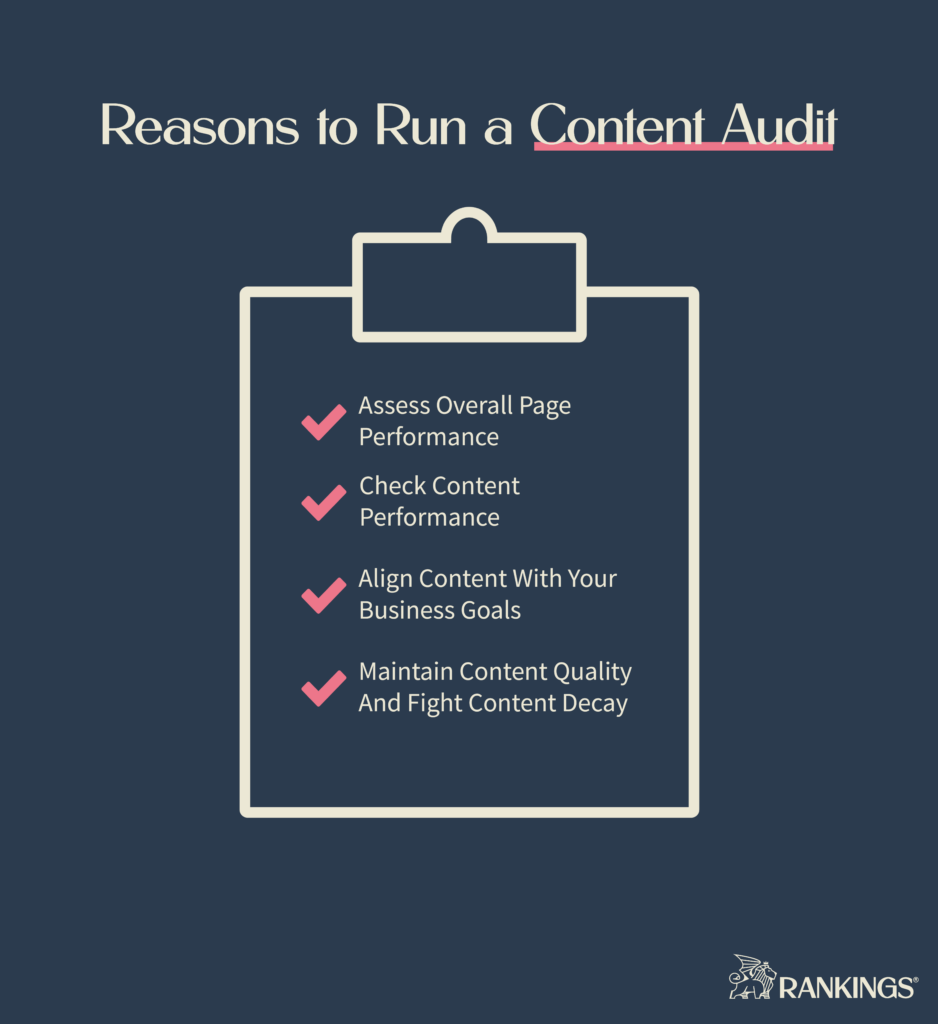Content audits can be a game changer for your website.
These SEO tools let you see what’s working, what’s not, and where you can make changes to get better results. By following our step-by-step guide, you’ll learn how to run your own audit and make smart choices for your content.
To make it even easier, you can download our free, easy-to-use Google Sheets template to streamline the process.
What is a Content Audit?
A content audit is like a health check-up for your website.
This specialized type of SEO audit looks at a website’s existing content to assess its strengths and weaknesses. The goal with one of these audits is to find opportunities to align your existing content with your business goals and the needs of your audience.
During the content audit process, you’ll review all of your site’s live content.
In the end, you’ll have a list of opportunities to update, move, or delete content to improve your overall performance on Google.
Why Run a Content Audit?
A content audit is a useful way to discover how your current content is performing.
With a content audit, you can learn:
- Which pages on your site are driving the most traffic, links, and conversions
- Which pages may have room for improvement
- Which pages don’t provide your business with any value at all
This knowledge can guide your content tactics moving forward.
A content audit can’t show you things like technical or user experience issues. But it can show you when a page that should be valuable has a problem. Highlighting pages that don’t perform well can point you in the right direction to find and diagnose deeper issues.

These audits can also help you fight against content decay.
Audience preferences and search intent can change rapidly. This can lead to your content performance decaying over time. You might discover content that’s no longer relevant, accurate, or engaging for your audience.
Regular audits can help you stay on top of these changes and avoid losing ground.
It can also help you align the content on your site with your business goals. A content audit is a must if you‘ve published a lot of content in the past without a plan. The same is true if your business recently changed direction.
You may discover pages on your site that don’t make any sense for your business.
A content audit collects all of these issues—content quality, business relevance, and page experience—into one report. It’s an easy way to find your issues and plan a way to resolve them.
And when you resolve them, you set yourself up for a site that performs better than ever for both search engines and people.
Most content audits only look at the number of visitors coming to each page on your site—both from search engines and all sources. They then look at how many backlinks each page has.
This can give you some sense of how well each page performs, but it leaves out a critical factor—conversion events.
A page that only has one backlink and gets 100 visitors per year may not seem valuable. But if 1% of those visitors convert and the value of the conversion is high enough, then it’s tough to say that the page is a low performer.
That’s why we built our content audit template to consider conversion rates in addition to the standard performance metrics.
What You Need to Get Started
Gathering the data for your site audit requires access to a few different tools.
First, you need a tool that can crawl all of the live pages on your site.
We built our content audit template to work with data from Ahrefs. But if you have the technical skill and time to reconfigure data, you could use a crawler like Screaming Frog.
Next, you’ll need access to your website’s Google Analytics account.
Our template uses data from Google Analytics 4. If you haven’t configured your site for GA4 yet, you will need to upgrade to it. You’ll also need to have your conversion events and goals configured in GA4.
Finally, you’ll need a tool to collect data on all the backlinks pointing to pages on your site. This is where Ahrefs will come in handy again.
1. Make a Copy of Our Free Content Audit Template
Before you start grabbing all the data you can get your hands on, you need a place to put it.
To begin, click here to make a copy of our content audit template. You can follow the walkthrough below to see how to make a copy and set it up.
The template will automatically transform the data you import into recommendations for your site. By the end of the data-gathering steps, you’ll just need to look at the Master tab to find all the recommendations.
But that’s getting ahead of ourselves. First, you need to start exporting data from your tools.
2. Get a List of the Pages on Your Site
The first dataset you need is a list of URLs on your website.
One of the easiest ways to get this data is by using Ahrefs Site Audit, especially if you already use it for your other website audits.
Go to Ahrefs, find the Site Audit tool, and follow the walkthrough below to export your page data.
Once you’ve exported the data from Ahrefs, you can import it to the Ahrefs Site Audit tab of your content audit sheet. The walkthrough below will show you how to import the site data.
Making sure that you add the data to the right tab in cell A1 is critical. Trying to add the data to the sheet in any other way could interfere with the formulas in the Master tab.
You’ll follow the same steps outlined in the walkthrough above to import data in the next four steps.
3. Import Page Traffic Data from Google Analytics
The next dataset to add to your audit has to do with the traffic that your site gets. You need to get a list of all the pages on your site that get visitors. You’ll also want this list broken out so you can tell whether the visitors to each page found the page through organic search.
To do that, you’ll need to leave Ahrefs and go to your site’s Google Analytics account.
The walkthrough below will show you how to pull page-level traffic data from GA4.
Once you import that data into the template, you’ll see which pieces of content get the most traffic from all sources, the most traffic from organic sources, and no traffic at all.
But looking only at the traffic each page gets won’t give you a complete picture of their performance or potential.
You have to dig a bit deeper to get that.
4. Get Landing Page Conversion Data from Google Analytics
The next thing to grab is conversion data for each page on your site.
Many SEOs leave this part out of their content audit framework, choosing to focus on traffic and links. But leaving conversion data out of your audit means you lose valuable insights.
For example, a lawyer could have a blog post or service page on their site for people who have been injured in train accidents. That page may not get a lot of traffic in 12 months. It probably isn’t a link magnet, either.
But taking on a train accident case is worth a lot of money to many personal injury attorneys.
If the page leads to the attorney getting just a few new train accident cases, it may be worth keeping.
Adding conversion data to your audit helps you justify why an “underperforming” page should stay on your website.
You’ll need to use the Landing Page report in Google Analytics to get this conversion data. Here’s how:
Make sure to check the conversion events in your report before you export it. You may have set your conversion events up to track things like dwell time or scroll depth. Those kinds of events aren’t valuable for a content audit.
Instead, you want to export conversion events for goals like calls, form submissions, purchases, or appointments booked.
5. Pull Attribution Data from the Model Comparison Tool in Google Analytics
There’s one other type of conversion data to export from Google Analytics before you move on.
Attribution data measures indirect conversions, while the previous step measures direct conversions.
Sometimes people find a page through one medium, explore the site for a while, and then leave. Later, they return to the site through a different medium and convert.
The last page gets the credit for the conversion in a standard conversion model.
But what if someone finds your site through Google, bookmarks the page, and then comes back to the site days later through a direct visit?
You can attribute at least a small part of that conversion to the visitor’s first interaction with your brand through their Google search.
The Model Comparison Tool in Google Analytics makes finding this first-touch data simple. Here’s how you can find and export this information for your content audit:
Once you’ve added the attribution data to your content audit sheet, you can move on from Google Analytics.
6. Gather Backlink Data from Ahrefs
The final dataset you will need to find is the number of backlinks pointing to each page.
You’ll need to return to Ahrefs and use their Best by Links report. Follow the walkthrough below to find this type of data.
That’s the last piece of data you’ll need to capture for your content audit. Now, it’s time for you to decide what you’ll do with it.
7. Review the Audit Data and Plan Your Actions
Now that all of the data is in the sheet, the Master tab should have a recommendation for every live page on your site. The content audit sheet will give each page one of four different recommended actions:
- Leave As-Is
- Redirect or Update
- Delete
- Manually Review
But the recommendations that the sheet gives you aren’t final. The content audit template can only provide recommendations based on the metrics it can see. There may be other elements at play that the metrics don’t show right away.
It’s ultimately up to you to decide what the final action should be.
Here’s an example of that decision-making process in action:
Before you decide to redirect or delete a page for poor performance, there are a few other things to consider. A valuable page might have bad metrics but be valuable for other reasons.
Here are some questions to ask yourself in these situations:
- When was the page published? New pages can sometimes be marked for deletion if they haven’t had the chance to gain traffic.
- Does the page serve a role in the site architecture? Category and author pages don’t generate traffic or links but are essential for the site structure and EEAT.
- Do you use the page for other parts of your marketing? Advertising or social media landing pages won’t get a lot of organic traffic, but they still serve a purpose elsewhere.
- Is the page a part of the customer journey? Some informational pages do not convert but push visitors further down the funnel.
Having conversion data in your content audit can alleviate a lot of the stress in determining the value of a page. By looking at the number of conversions that a page was responsible for, you can tell whether it’s worth keeping whether or not it’s a high-traffic page.
It can also show you clear opportunities for improvement.
Pages with low traffic but high conversion rates may need to be updated. Running a competitor keyword gap report for that page may surface some content optimization options for you.
Reviewing each page and setting your next actions is the final step in any content audit. You’re now ready to take your decisions and put them into action.
How Often Should You Run a Content Audit?
Your content audit frequency depends on various factors. The size of your website, the rate at which you produce new content, and the industry you operate in all play a role. A general guideline is to conduct a full content audit at least once a year.
But content audits are only one part of keeping your content fresh, relevant, and valuable to your audience.
Content audits can show you pages that are decaying in terms of traffic and conversions. They can help you spot the pages that need to be deleted or updated. But they can’t always tell you why a page needs a specific action.
We recommend running your content audit in tandem with other tools.
Technical SEO audits, holistic website audits, and specialized SEO audits can help you uncover the underlying issues that cause bad performance. They’ll also help you with things a content audit can’t do, like finding broken internal links, files, and page descriptions.
By running these alongside your content audit, you may discover that a page your content audit recommended for deletion only has a minor technical issue to resolve. Or you may see that the performance issue is tied to poor keyword targeting.
Final Thoughts
Content audits are useful for discovering what’s working and what’s not on your website.
By blending traffic, link, and conversion data, you can discover the biggest opportunities for updates to your website. Using the steps and template found in this guide, you’re well on your way to finding new ways to improve your site.
Analyzing your website’s pages can take a lot of time. And if you pair your content audit with any other recommended SEO audit, that investment can increase exponentially.
While these audits are valuable, many business owners prefer to outsource the work to an SEO expert.
At Rankings.io, we serve elite personal injury law firms. A content audit may be a valuable way to improve your law firm website, but you may not have the time in your schedule to dig through page performance metrics. If working with the premier expert in law firm SEO sounds like the best solution for you, don’t hesitate to contact us today.
The post How to Do a Content Audit (with Interactive Guides + Template) appeared first on Rankings.



